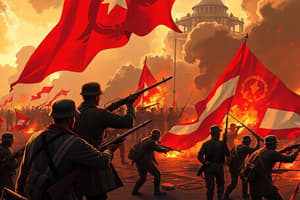Podcast
Questions and Answers
What role did conscription play in the mobilization of societies during World War I?
What role did conscription play in the mobilization of societies during World War I?
Conscription allowed nations to draft millions of men into the military, ensuring that armed forces were reinforced with enough personnel for the total war effort.
How did World War I affect women's roles in society?
How did World War I affect women's roles in society?
Women took on roles in factories and farms to support the war effort, as many men were conscripted into military service.
What economic changes occurred due to the war?
What economic changes occurred due to the war?
Civilian industries were repurposed for war production, and governments imposed strict controls and rationing of resources to support the military.
In what ways did technology contribute to the destructiveness of World War I?
In what ways did technology contribute to the destructiveness of World War I?
How did governments use propaganda during World War I?
How did governments use propaganda during World War I?
What was the significance of the casualties and destruction caused by World War I?
What was the significance of the casualties and destruction caused by World War I?
Explain the global dimension of World War I.
Explain the global dimension of World War I.
What developments led to World War I being classified as a 'total war'?
What developments led to World War I being classified as a 'total war'?
Flashcards
Total War
Total War
A type of warfare where a nation mobilizes its entire population, economy, and resources for the war effort, impacting civilians and the military.
Mobilization of Entire Societies
Mobilization of Entire Societies
Conscription of millions of men, women working in factories and farms, and government propaganda used to rally civilian support.
Economic Reorganization
Economic Reorganization
The economy shifts to war production, with civilian factories converted to arms manufacturing. Governments control resources like food and fuel, leading to rationing and state-directed economic activity.
Technological Advancements
Technological Advancements
Signup and view all the flashcards
Wartime Propaganda
Wartime Propaganda
Signup and view all the flashcards
Widespread Casualties and Destruction
Widespread Casualties and Destruction
Signup and view all the flashcards
Global Scope of World War I
Global Scope of World War I
Signup and view all the flashcards
Transformation to Total War
Transformation to Total War
Signup and view all the flashcards
Study Notes
Total War in World War I
- Definition of Total War: A conflict where a nation fully mobilizes its resources, economy, and society. It impacts both military personnel and civilians.
Factors Driving the Shift to Total War
-
Mobilization of Entire Societies: Countries like Germany, France, Britain, and Russia conscripted millions and employed women in factories/farms, controlling their populations for the war effort. Propaganda was used to rally civilian support.
-
Economic Reorganization: Industries shifted from civilian goods to war production (e.g., factories converted to weapon production). Governments tightly controlled resources (rationing), directing economic activity.
-
Technological Advancements: New weapons (tanks, machine guns, poison gas, airplanes) made the war more destructive, demanding massive resources and directly impacting civilian populations. (Air raids and gas attacks).
-
Wartime Propaganda: Governments used propaganda to boost morale, demonize the enemy, encourage nationalism, and motivate citizens to contribute (enlistment, labor, finances).
-
Widespread Casualties and Destruction: The massive scale of death and destruction impacted all aspects of society (military and civilian). This included disruption of agriculture and industry.
-
Global Scope: The war extended beyond Europe, drawing resources and personnel from colonies worldwide to support the war effort. Colonial troops fought, and resources were taken from colonies; thereby, it had global impacts.
Studying That Suits You
Use AI to generate personalized quizzes and flashcards to suit your learning preferences.




